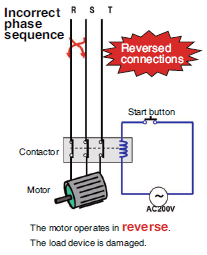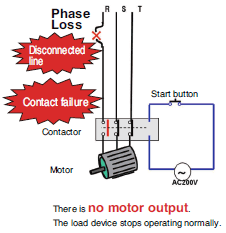Measuring / Motor Protective Relays
|
|
Features |
| Principles | Classifications |
| Engineering Data | Further Information |
|
|
Troubleshooting |
Three-phase AC Power Faults
The types of faults that can occur in machines and equipment that use three-phase AC power supplies include incorrect phase sequence, phase loss, three-phase asymmetry, overvoltage, and undervoltage.
Concretely, in order to prevent malfunctions, motor burnout, and other troubles that can be caused by power supply faults, incorrect phase sequence, phase loss, voltage asymmetry, overvoltage, undervoltage, and other faults are detected to protect devices and equipment and to shorten recovery work time.
Incorrect Phase Sequence
Incorrect phase sequence indicates that part of the phase sequence of a power supply is in the opposite order, e.g., due to incorrect wiring. This causes the motor to operate in the reverse direction from its normal one.
The sequence should be R, S, T, R, S, and then T, but if it becomes S, R, T, S, R, and then T, the rotation direction is reversed.
The motor operating in reverse moves a conveyor in reverse or moves an elevator or escalator in the opposite direction from normal, creating a major hazard and possibly damaging the machine too.

Phase Loss
Phase loss indicates the status in which the motor is operated on a single phase because of a disconnected motor power wire, loose connection, switching contact defect, or disconnected wire inside the motor.
When a phase is lost, the motor does not start or even if it operates, it does not do so smoothly and as a result, the motor does not provide its specified output and the motor itself may overheat and burn out.

Three-phase Asymmetry
If there is fluctuation in the load capacity or circuit current between the wires for a three-phase load, voltage asymmetry occurs.
If this happens, the three-phase device (e.g., motor) may heat up, break down, become louder, etc.
Overvoltage and Undervoltage
A power voltage fluctuation leads to device and machine malfunctions and damage.


